While the internet has been a boon for detailed information about musical genres and artists, there is one problem: often these pages disappear after a few years. This can be because the creators forget to pay their bill for hosting, or they lose interest, or some other development that sends the pages into outer space. A few years ago Sholto Duncan of New Zealand’s National Library wrote a piece on this topic for AudioCulture: The Lost Websites
Luckily, the National Library has come up with a deft solution: “harvesting” these important New Zealand websites. While they are active, the Library copies them and makes them available on its website. At the Library’s site, the pages they harvest may be inactive – that is, some of the internal links may not work – but it’s better than losing all that information that was once published with love and scholarship.
Two crucial websites on New Zealand music history have recently been harvested: New Zealand Folksong, and Memories of New Zealand Musicians. Nick Bollinger took a deep dive into both sites and has shared some of his discoveries.
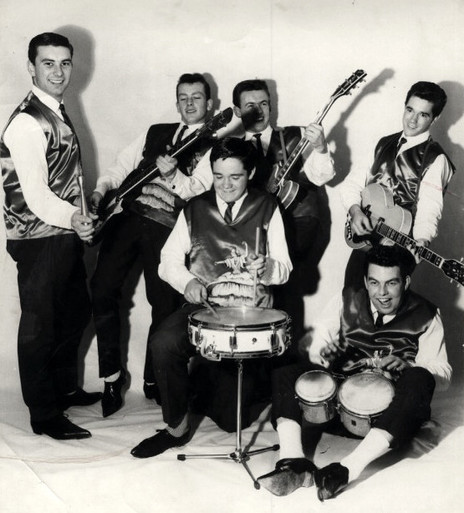
Andy Shackleton at the snare drum with the Premiers. The others are, from left: Barry Millage, Peter Hindmarsh, Neil Harrap, Ken Cooper (on bongos), Mike Shackleton.
On the home page of Memories of New Zealand Musicians, the website he founded in 2007, the late Andy Shackleton noted that while there have been a number of great books written about New Zealand popular music, their focus tends to be on the “celebrity performers”. Yet in the rhythm sections and road crews of every great band or star, are figures less visible yet equally essential. These are the people whose musical lives he set out to document.
“These pages tell the story from the musician’s point of view, bringing back some long-forgotten memories and personal details,” he writes, lamenting that “a number of the musicians that I grew up with have now passed on, their memories lost forever.”
It is fitting then, that since Andy’s own passing in 2019, the National Library has archived his site, making the material he assembled indefinitely available to researchers, fellow musicians, and anyone interested in the untold stories of this country’s pop music past.
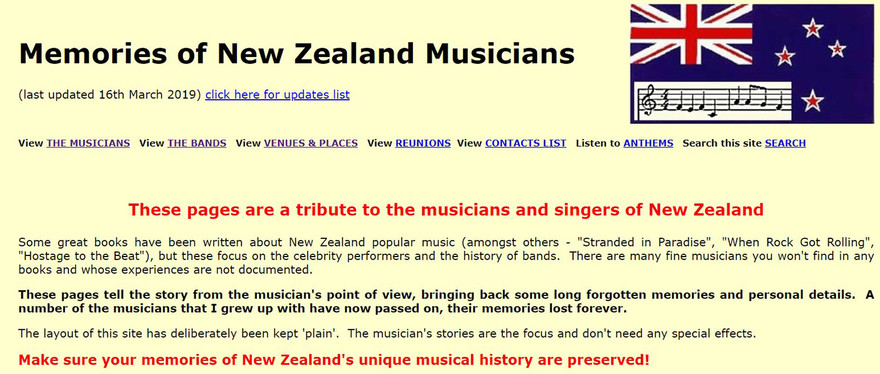
The home page of Memories of New Zealand Musicians.
Andy created individual page headings for Bands, Musicians, Venues and Contacts, plus a section whimsically devoted to renditions of the national anthem, arranged by musicians in the style of their choice, though this never grew beyond initial contributions from Rod Stone and Trevor Judge. The site also came to include a sobering number of obituaries.
Andy’s approach was democratic. There was no style guide. Contributors were free to share their thoughts and memories in as concise or expansive a prose as they saw fit. It all adds up to a trove of anecdotes, biographies, arcane details and intriguing clues about hundreds of bands, from Aardvark to Zingaro, and the musicians that played in them.
Though the stories reach as far back as the 1940s and all the way through to the 2020s, the prime focus is on the 1960s. While it was clearly not Andy’s intention to make himself the centrepiece, he stood at a nexus of several local music scenes, particularly in Wellington and Auckland, and you will find just a degree or two of separation between him and many of the individuals in these pages.
His own story, accessed through the musicians’ index, is a good place to start. “There was something special about Miramar and music back in the early 60s,” he writes. “A 10-minute walk around the block from our house passed the houses of Glyn Tucker, Neil Harrap and Doug Harrap and John Donoghue …”
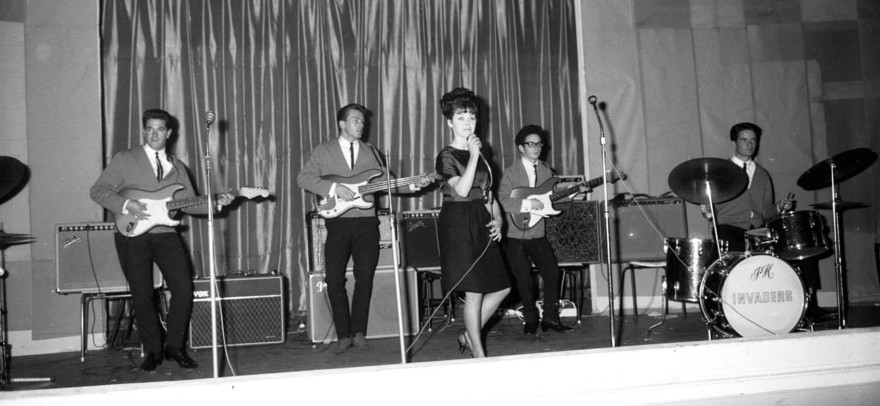
Lyn Barnett, backed by Wellington's Premiers at the Oriental Ballroom, Auckland, 14 May 1964. The Premiers are, from left: Mike Shackleton, Peter Hindmarsh, Jimmy Ellyet, and Andy Shackleton (playing Jimmy Hill's drum kit). - Rykenberg, Auckland Libraries Heritage Collections 1269-W0240-11
All of these neighbours would prove to be important in different ways. From playing guitar in assorted 60s beat groups, Glyn Tucker would go on to become a leading local record producer and studio owner. John Donoghue would make his name fronting Loxene Golden Disc finalists Timberjack before becoming a respected solo artist and founder member of The Warratahs, while Neil Harrap would be a leading session guitarist in the 60s, as well as a member of an early supergroup that, for a brief moment, rode the zeitgeist though were never recorded.
In his own entry here, Harrap recalls: “I was approached by John Koolman to start a band for his club on Ghuznee Street, the Sorrento. I called on Puni Solomon from [Ray Columbus and] the Invaders, Bruno Lawrence whom I had done a lot of recording with, and Puni found a vocalist/rhythm guitarist named Paul Mugglestone from Christchurch. We rehearsed in my parents living room in Rex Street and hit the stage sometime in 1964. We named the band The Measles. It rhymed with Beatles and was catchy (catch the Measles …) We played four hours Tuesday to Thursday, five hours Friday and Saturday, and three hours Sunday afternoon – as well as four hours Sunday night for a total of about 30 hours a week. We usually played 50 minutes of every hour. This was industrial music production and we sure earned our money. The gig paid well, £30 for every member, and I got the same, being a democratic fellow.”
Harrap has nothing but praise for his fellow Measles. “Bruno was an excellent rock drummer though he’d protested when I asked him to join. ‘I can’t play rock’n’roll Neil’ were his words. I told him he could and dragged him into it.”

At the Pines, Wellington, early 1960s (L-R): singer Mary Larkin, Bruno Lawrence, Garth Young and bassist Slim Dorward. - Garth Young Collection
But Harrap’s disenchantment with the venue meant the band would be short-lived. He describes The Sorrento as “a dive frequented by no-hopers, hookers and the like” and adds that “after about six months I looked around and decided that I had better things to do with my life than associate with this crowd.” He took off to Australia and hung up this guitar not long after.
Seeing Andy Shackleton’s brother Mike’s skiffle band The Swampdwellers (in which Neil Harrap had also played) set an eight-year-old John Donoghue on his musical path. “Inspired by the adventure of it all,” he writes, “I formed my own skiffle band at Miramar Central Primary School.” The band also included Eddie McDonald, later of The Avengers.

Swampdwellers, Miramar, c.1958 (L-R): Garry Foothead, Graeme Beadle, Neil Harrap, Mike Shackleton, Brian King.
Of Andy Shackleton, Donoghue recalls: “One day Andy and I were out in the Shackletons’ shed when suddenly, for no apparent reason, he tore his banjo apart and rebuilt it as a snare drum. That snare drum became the centrepiece of a “drum kit” he built out of all sorts of pots and pans and old buckets and stuff. He would sit in with Mike’s band when they practiced in the old shed. In no time at all he became their regular drummer.”
Andy would drum in an early line-up of The Librettos with guitarist Rod Stone, before forming The Premiers with his brother Mike, and Neil Harrap. Ken Cooper, who would go on to become an important local music entrepreneur, is credited in this early line-up with “bongos and management”.
Some frontline as well as background musicians are recalled. Schoolgirl singer Rochelle Vinsen had a best-selling hit in 1964 with ‘My Boyfriend’s Got A Beatle Haircut’ and again in a duet with Jim McNaught, ‘I Like Your Kind of Love’. She remembers how she got her first airplay, despite her debut single ‘Candy Kisses’ being deemed unsuitable for broadcast due to the volume of the backing band. “All my school mates were beginning to think I was a fake, so in desperation and once again in my college uniform, I went knocking on Bas Tubert the 2ZB breakfast announcer’s door. He happened to live a few doors down from Onslow College and he kindly played the flipside the following morning, and so all my friends believed me after all!”
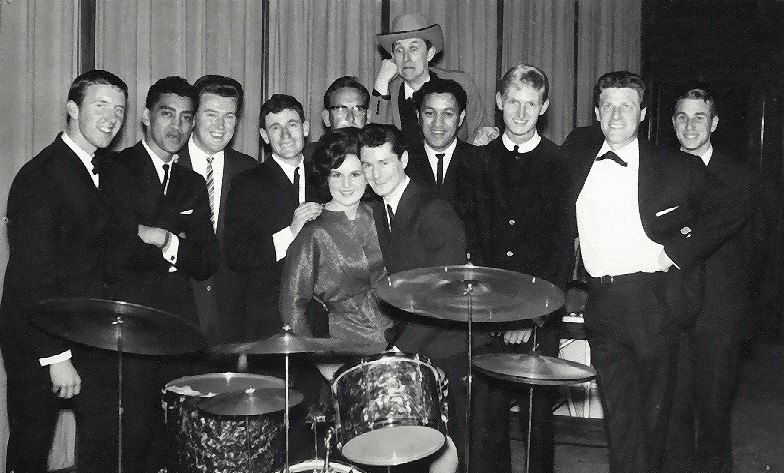
Just some of the lineup of the Christmas Spectacular at the Wellington Town Hall, 23 December 1963. Middle row (L-R): Ray Earle, Dennis Moreau, Byron Knight, Tom McDonald, unidentified (possibly George Neate), Lani Love, Tommy Adderley, Neville Chamberlain, and Bruce Warwick. In front: Rochelle Vinsen and Peter Posa. The man in the hat is unidentified. Also on the bill were the Cascados, and folkies the Wayfarers and the Folkestone Three.
British-born Peter Hindmarsh, who played bass in bands with both Andy Shackleton and Neil Harrap in the early 60s, recalls his time at Auckland’s The Top 20 club, backing singer Tommy Adderley. “A bespectacled fuzzy-haired ball of loyalty, dry humour and willingness. For me, Tommy was the deal. Professional, funny, respected and respectful. A lovely man. Sartorial, pitch perfect, well rehearsed, made us sound good. He lived rock and roll, blues and jazz.’
And he recalls another gig with the singer, nearly 30 years later. “We played a Christchurch gig shortly before he died. I was his bass player. Nothing was different. There he was, out in front as usual. Cathartic. The man and his harps. I was lucky to stand behind and play for him that one last time. Special. After the gig I hugged him. He wasn’t well. He said ‘Hey, dig the bass, man.’ Then: ‘The 20. Not bad eh? I loved you guys. Had it down and didn’t mess about.’ ”
Degrees of separation may be few in the local music scene, still I was surprised when one of my own family popped up in these pages. Pat Southee (who played with Jim McNaught in The Supersonics) recalls a young Beverley Morrison – who would later become well known as the vocalist Beaver – from the time they worked together at the United Empire Box Company, along with their mutual friend, my uncle Max Bollinger. He notes that she was a frequent guest at the Bollingers’ home in Titahi Bay, but confesses he did not realise that she was a singer until years later when he heard her with BLERTA, so during all their time as workmates they never discussed their shared passion for music.

The front page of the extensive "Bands" section of the Memories of New Zealand Musicians website.
Some of the entries are brief and prosaic. Others, like that of guitarist Kevin Watson, are expansive and rhapsodic. Watson spends several paragraphs vividly describing his childhood on the Te Kauwhata Horticultural Research Station before we get to his first musical notes.
“Because we lived in the country without street lights, the night sky could be dramatic. The sizes and colours of the stars were plain to see, and had already aroused my curiosity. In town there was a general store called Pulham & Begbie. One memory that always sticks is of slim old Māori ladies, with head scarves, cardies and moko, sitting on the footpath outside the store smoking pipes. In the shop one day I saw a book called Stars and Planets. I opened it and saw pictures of Jupiter and Saturn, and the same eerie feeling came over me that my known universe had suddenly expanded. I became aware of the mystery of space. How big is it? Does it have and end, and what’s past the end?”
Watson’s corner of the universe would soon be shaken by a comet, though it didn’t come from outer space. “The first rock’n’roll hit in New Zealand was ‘Rock Around The Clock’ by Bill Haley and the Comets. The rhythm was something I had not heard before, and I remember again that feeling of discovering something exciting and new. So another obsession was born, one which remains as strong as it was then …
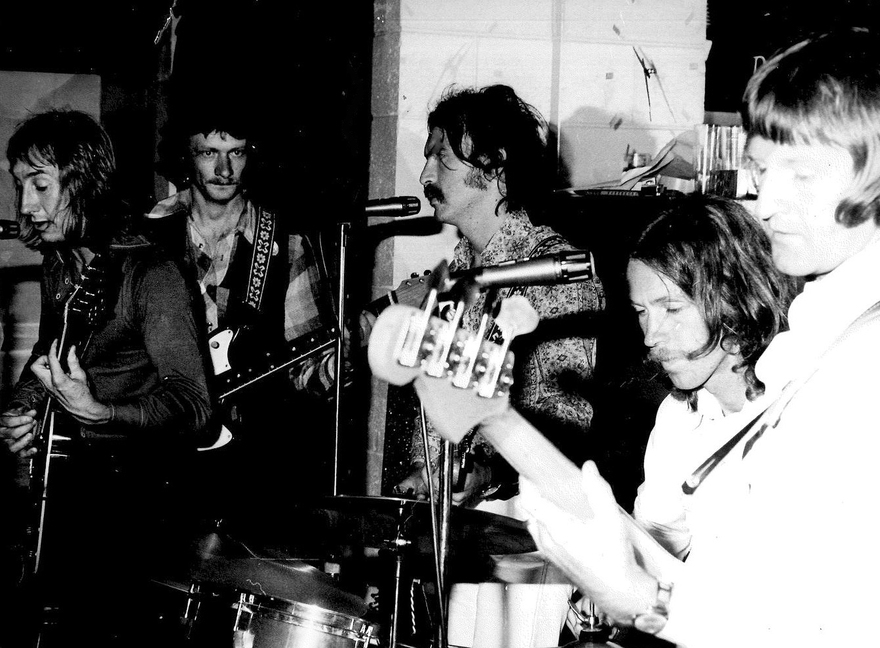
The Country Flyers (from left): Midge Marsden, Kevin Watson, Martin Hope, Jim Lawrie, Richard Nicholson
“My mother had a guitar, which was very unusual for pākehā households in those days. It was kept in a case lined with green felt, and usually lived in a cupboard. She almost never played it. From when I was quite young I used to get it out and play with it or just look at it. It was a Hawaiian steel guitar – just like a small acoustic guitar with high string action, and tuned to an A chord. From my piano knowledge I figured out where the notes were and used to pick out tunes.”
Watson would go on to become a busy session musician, recording with Rochelle Vinsen, Maria Dallas, Garth Young and many others, and playing with the Country Flyers. He writes of venues and musicians, and even has a ghost story concerning Harold, the former manager of Wellington’s Empress Ballroom. “When he was alive, Harold lived in a flat above the dance floor. Legend has it that if the band was too loud, he would come out and stand on his balcony overlooking the dance floor, shaking his fist. Legend also has it that, at times after his death, the Ghost of Harold could be seen up on the balcony. Being personally familiar with the amount of insobriety prevalent at such places, evidence on this phenomenon may be unreliable.”
Other believe-it-or-not tales shared in these pages include the rumour that 60s heartthrob Mr Lee Grant was once offered the role of Ozzy Osbourne’s replacement as singer in Black Sabbath. “I’ve heard his tapes with Iommi and the guys,” testifies Peter Grattan.
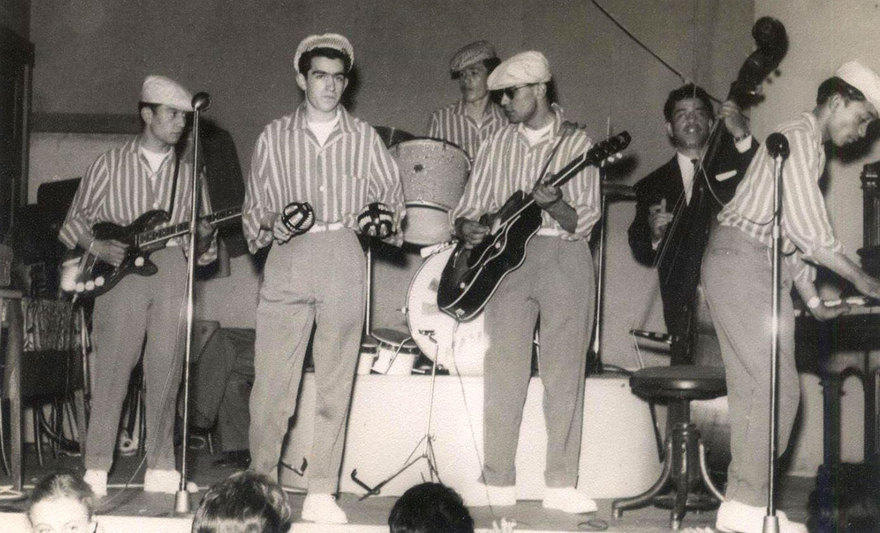
The Hi-Five Mambo (later the Māori Hi-Five) in Whanganui, October 1958: Ike Metekingi, Costa Christie, Jimmy Rivers, Rob Hemi, 'Fro The Pro' (a guest), and Sol Pohatu. - Costa Christie collection
Costa Christie, an early member of the Māori Hi-Five, fills in details of the Step-A-Side, the burger bar he managed in the early 60s. “Being one of only two all-night burger bars in Wellington – Roy’s being the other – we were privileged to meet all the ‘night’ people, especially the musos. I believe that ‘anyone who was anyone’ passed through our doors at one time or another. Future Prime Minister Norm Kirk would often turn up in his slippers in the wee small hours.”
Ross Burgess tells of how he started out “an ardent Shadows fan – had all their records while still at college and after persuading my father to help finance an electric guitar I became the proud owner of a Kawai. The only trouble – I didn’t have a clue how to play it. Spotting a fellow with a guitar case waiting for a bus, he turned out to be Paul Densham, who played in a group called the Electrons. They had a regular fortnightly gig at a youth club in Kelburn and practiced in a plumber’s workshop in Molesworth Street opposite Parliament … I started to hang out with them and soon became the roadie …” Though Burgess never became a musician he would go on to roadie around New Zealand and Australia with various rock and blues bands including The Phil Jacobs Combo and The Joyful Crye.
An unapologetic longing infuses these pages. Brian Bushby of The Latter Rain and No Thoroughfare, remembers the 60s as “unsurpassed by any period either before or since for its creativity, colour, diversity, intensity, enthusiasm and gaiety. It seemed as if every suburb in every city and every small town and every village in New Zealand spawned its own rock and pop bands. New dances were devised almost bi-monthly and clothing designs and hairstyles constantly went through many changes; often outlandish but always driven by whim and fun. Girls particularly were incredibly attractive and vibrant. Those of us who were there certainly remember the go-go girls and the hippie maidens with a very deep fondness. Oh, if only we could go back to those days, even for just one fleeting month …”
Others, like Peter Hindmarsh, prefer to keep it brief. As he writes: “No encore. That’s me done. A small ripple in a big pond. Happy to have been there.”
--
Memories of New Zealand Musicians at the National Library website:
See also: Folksong.org.nz: John Archer’s repository of NZ folk